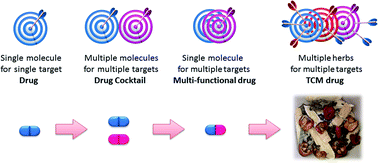Covering: up to 2010
After new human transmissible H1N1 (swine flu) viruses were reported in Mexico and the United States in April 2009, the World Health Organization (WHO) announced the emergence of a novel influenza A virus. Most governments in the world have been alerted and are monitoring the situation closely. As one of the official responses to the H1N1 pandemic, the Chinese government has released three editions of a document entitled “Recommended Schemes for Pandemic Influenza A Diagnoses and Treatments”. The third edition recommended the use of not only two targeted anti-flu drugs, oseltamivir and zanamivir, but also four anti-flu TCM (Traditional Chinese Medicine) prescriptions. Since then, TCM has played a significant role in fighting the pandemic. TCM drugs comprise multiple compounds regulating multiple targets for a given class of medical indications, and are tunable to the symptoms of the individual. This review summarizes anti-influenza agents from TCM, including compounds, herbs, and TCM prescriptions, and suggests that, by further investigating TCM theory and mining TCM databases, a better drug discovery paradigm may arise – one that can be beneficial to both TCM and modern medicine.

You have access to this article
 Please wait while we load your content...
Something went wrong. Try again?
Please wait while we load your content...
Something went wrong. Try again?


 Please wait while we load your content...
Please wait while we load your content...